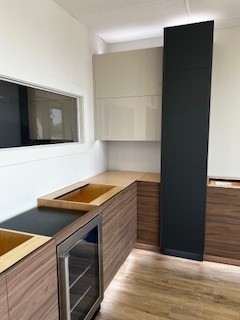Frameless vs Face Frame Cabinets: Storage Showdown for Your Kitchen Remodel
When comparing frameless vs face frame cabinets, the debate often boils down to one key question: which style maximizes your kitchen’s storage without sacrificing style or durability? At Midtown Cabinets, we’ve helped countless homeowners navigate this choice, and the answer lies in understanding the structural differences. European frameless cabinetry (also known as “full-access” or “Euro-style”) skips the traditional face frame, attaching doors and drawers directly to thicker side panels for sleeker lines and superior space use. In contrast, American face frame cabinets feature a sturdy 1-1/2-inch wooden border around the box front, offering timeless appeal but eating into interior room.
If you’re remodeling and wondering about frameless cabinets for storage gains, frameless designs typically deliver 4-20% more usable space in the same footprint. This boost comes from wider drawer openings (up to 1.5 inches extra) and unobstructed access, perfect for pots, gadgets, or everyday essentials. Let’s break it down by key factors, cabinet types, and pros/cons to help you decide.
Why Storage Capacity Matters
That face frame on American styles adds stability and a classic look but shrinks interior dimensions—especially for drawers and pull-outs. Frameless cabinets eliminate this barrier, using robust 3/4″ sides to support heavy loads while freeing up every inch.
Industry data from top manufacturers shows frameless options edging out framed by 4-20% overall, depending on your layout. Base cabinets see the biggest wins, while wall units show little variance. Plus, many frameless lines add an extra inch of depth (24 inches vs. 23 inches), bumping linear storage by another 4%. For accessibility, full-overlay doors in frameless setups mean no frame to snag on—making grabs 10-15% easier in busy multi-door zones.
Key Factors Driving Storage Differences
- Drawer and Pull-Out Efficiency: Face frames cut ~3/4 inch from each drawer side, slashing total width by 1.5 inches. In a standard setup, that’s an 8% volume drop—framed cabinets just can’t compete for bulky items.
- Kitchen-Wide Impact: Across a full remodel (base, tall, and wall cabinets), switch to frameless for ~4% net gain, scaling up in drawer-heavy designs.
- Depth and Material Perks: Thicker panels in frameless allow deeper builds without wobble, while the no-frame design supports custom inserts like lazy Susans.
- User-Friendly Access: Say goodbye to reaching past lips—frameless doors swing wide for effortless organization, ideal for families or avid cooks.
Frameless vs Face Frame Cabinets: Breakdown by Type
To visualize the difference, check this comparison table. It’s based on 24-inch-wide standards from experts like Conestoga Wood Specialties—real-world specs for informed decisions.
| Cabinet Type | Framed (American) Interior Width | Frameless (European) Interior Width | Storage Boost in Frameless | Quick Notes |
|---|---|---|---|---|
| Base Cabinet (Single Drawer) | ~22.5 inches | ~24 inches | +1.5 inches (~7-8%) | Perfect for pots; no lip means smoother slides. |
| Base Cabinet (4 Drawers, 15″ Wide) | ~10.25 inches per drawer | ~12 inches per drawer | +1.75 inches per (~17%) | Total opening widens by 1.25 inches—utensil heaven. |
| Tall Cabinet (Lower Drawer) | ~22.5 inches | ~24 inches | +1.5 inches (~7%) | Boosts bottom access; shelves stay the same. |
| Wall Cabinet | ~24 inches (full) | ~24 inches (full) | 0% | Frame irrelevant here—no drawers to cramp. |
| Full Kitchen (20 Linear Feet Avg.) | ~80-85% utilization | ~85-100% utilization | +4-20% overall | Drawer-focused kitchens win big; add depth for more. |
As you can see, it isn’t just about numbers—it’s about fitting your life into smarter spaces.
Pros and Cons
No decision is black-and-white, so here’s a balanced look at frameless vs face frame cabinets for storage-savvy remodels:
Frameless Cabinet Pros:
- Up to 20% more room for gear, especially in compact urban kitchens.
- Modern, seamless vibe with endless customization (think soft-close everything).
- Easier deep-reach access—less bending, more baking.
Frameless Cabinet Cons:
- Precision install needed to prevent sags (we handle this at Midtown!).
- 10-20% higher upfront cost for premium materials.
Face Frame Cabinet Pros:
- Rock-solid for heavy hauls, with that frame adding extra rigidity.
- Budget-friendly tweaks on-site and a cozy, traditional charm.
- Forgiving for DIY vibes or vintage-inspired homes.
Face Frame Cabinet Cons:
- Lost inches add up—tough for maxed-out storage needs.
- Narrower drawers mean fumbling for the back-row spatula.
Bottom line: If storage reigns supreme in your frameless vs face frame cabinets dilemma, go frameless for drawer-dominated zones. It’s a game-changer for efficiency without the clutter creep.

Frameless “Euro” Cabinets

Face Frame “American” Cabinet
Aesthetic Edge: Tighter Reveals and Modern Vibes in Frameless Cabinets
One of the standout perks in the frameless vs face frame cabinets debate is the sleek, upscale aesthetics of European frameless designs, thanks to their ultra-tight 1.5mm reveals—the slim gap between doors and panels that creates a flush, almost seamless facade. Unlike the wider 1/2″ reveals in traditional American face frame cabinets, which can highlight that charming but chunkier border, frameless setups hug the edges with precision, evoking high-end minimalist kitchens seen in luxury European showrooms. This refined detail not only amplifies a contemporary, clutter-free vibe but also pairs beautifully with matte finishes, integrated handles, and bold hardware, transforming your space into a modern sanctuary that feels both expansive and effortlessly sophisticated. If you’re eyeing frameless vs face frame cabinets for that wow-factor remodel, these tighter reveals are your ticket to timeless elegance without the visual bulk.
Ready to Maximize Your Space?
Ditching the debate on starts with a custom consult. At Midtown Cabinets, we blend European innovation with American reliability to craft kitchens that store more and stress less. Contact us today for a free design session—your dream layout (and extra drawer space) awaits!
